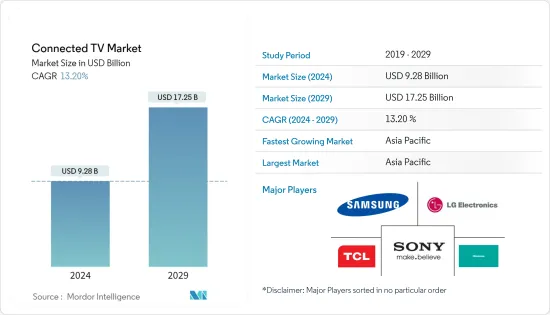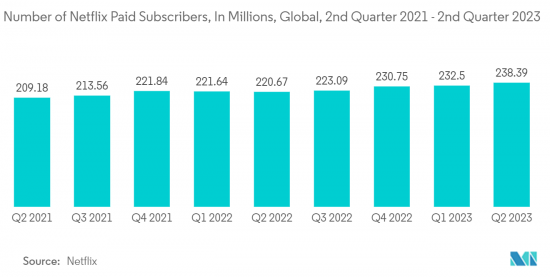 |
市場調查報告書
商品編碼
1406889
聯網電視:市場佔有率分析、行業趨勢和統計數據、2024 年至 2029 年的成長預測Connected TV - Market Share Analysis, Industry Trends & Statistics, Growth Forecasts 2024 - 2029 |
||||||
※ 本網頁內容可能與最新版本有所差異。詳細情況請與我們聯繫。
預計2024年聯網電視市場規模為92.8億美元,預計2029年將達到172.5億美元,在市場估計和預測期間(2024-2029年)複合年成長率為13.20%。

連網智慧電視將負責改變電視產業,因為它們透過網路服務提供標準CRT電視所不具備的廣泛創新。該電視配備 Wi-Fi 和乙太網路端口,允許用戶連接到網際網路。
主要亮點
- Apple TV、Amazon Fire TV 和 Google Chromecast 等串流媒體正在改變消費者的觀看習慣。一些製造商正在與Over-The-Top內容和設備供應商合作,提供無需機上盒的內建功能。例如,TCL公司與Roku公司合作推出4K HDR電視。
- 此外,電視製造商還在用戶介面、內容集中和應用開發方面的最新進展上競爭。例如,智慧型電視配備的作業系統可以運行用於串流視訊和音樂的應用程式和Widgets。智慧型電視提供各種先進的運算功能以及與常見網路功能的連接。這使得消費者能夠在智慧型電視上搜尋、交談、探索、共用、更新和下載多媒體內容,從而推動了對聯網電視的需求。
- 此外,世界媒體的快速數位化正在以數位化和智慧替代品取代傳統電視螢幕,進一步刺激市場開拓。此外,在美國,隨著消費者人均收入的增加和產品變得更加容易取得,對智慧聯網電視的需求也在增加。
- 此外,由於環境智慧、自動用戶援助和消費者可支配收入增加等功能,智慧型電視在物聯網生態系統中的重要性日益增加,也推動了市場的成長。
- 因為它類似於電腦或智慧型手機,所以連接的電視可能會崩潰或死機。客戶對資料外洩以及透過網路連線未授權存取攝影機和麥克風的擔憂日益增加,這可能會限制評估期間聯網電視市場的成長。
- COVID-19 的爆發對所有消費者的生活方式和生活方式產生了巨大影響。由於就地避難令和在家工作的規定,在家中的視訊消費達到了歷史最高水準。開發中國家行動用戶的成長已成為智慧型電視的主要動力,因為越來越多的消費者希望繼續在家中的大螢幕上消費串流內容。
聯網電視市場趨勢
智慧型電視佔最大市場佔有率
- 與傳統電視相比,智慧電視具有前沿的功能和應用升級。此外,Apple 和 Roku 正在開發專用智慧型電視的作業系統。例如,LG 電子的 WebOS 和三星電子的 Tizen 使客戶能夠從商店下載程式並存取線上串流應用程式。
- 近年來,由於高速寬頻存取的增加,線上材料的觀看量急劇增加。此外,不斷擴大的電子產業開始與各種技術進步融合,包括語音命令和運算智慧,推動了對智慧型設備(包括智慧聯網電視)的需求。
- 此外,隨著各種智慧型電視品牌採用Android作為作業系統,觀眾現在可以輕鬆存取Netflix、Amazon Prime和Hotstar等流行的OTT服務。可以從 Android 作業系統存取 Facebook、Twitter、YouTube 等 Android 應用程式。
- 此外,藍牙遙控器允許觀眾在這些電視上存取語音命令。例如,SONY的 One-Flick 遙控器具有內建麥克風,可讓人透過語音搜尋任何內容。 Android 內建遊戲、音樂、電影和應用程式商店。
- 此外,包括 Amazon Fire TV、Apple TV、媒體設備和 Google Chrome cast 在內的多種流媒體的易用性估計會改變人們的體驗和觀看模式。 因此,製造商可能會迅速轉向與內容供應商和 OTT 設備製造商合作,以開發內置在電視中的功能。

亞太地區佔最大市場佔有率佔有率
- 在亞太地區,消費者可支配淨收入的成長正在推動智慧電視的需求。此外,Amazon Prime Video、HOOQ 和 Netflix 等Over-The-Top平台在該地區的日益普及也推動了市場成長。例如,2023年5月,三星推出了最新的Neo QLED智慧型電視系列,具有4K和8K解析度。最新的Neo QLED智慧型電視系列有50吋、55吋、65吋、75吋、85吋和98吋尺寸可供選擇。
- 此外,網路的普及也促進了智慧型電視銷售的增加,推動了市場的成長。 IBEF預測,到2023年,印度OTT視訊串流市場規模將達50億美元。預計年終,印度市場規模將達到8.23億美元,可望成為全球第十大OTT市場。
- 由於偏好從傳統電視轉向智慧電視,印度家庭正處於一個轉折點。中等收入群體生活方式的改變是由於收入增加、意識增強、新技術的採用以及網際網路普及的提高。此外,預計在預測期內加速印度智慧型電視市場成長的關鍵因素是政府舉措,特別是針對二線和三線城市的舉措。
- 此外,印度寬頻網路普及的不斷提高以及客戶對線上內容偏好的變化也有望刺激市場成長。 Netflix、Amazon Prime 和 Hotstar 等影片串流公司的大量投資增加了付費電視用戶。此外,Daiwa 最近推出了一款採用 webOS TV 的獨特 4K 超高畫質智慧型電視。這款 50 吋智慧型電視由 webOS TV 提供支持,並具有 ThinQAI 語音援助和 Magic Remote。
聯網電視產業概述
聯網電視市場有多個參與者。這些擁有大量市場佔有率的大公司致力於擴大其國際消費群。由於最近消費者興趣的增加,該行業被視為一個有前途的投資目的地。營運商正在投資新興技術來開發大量專業知識,以提供長期競爭優勢。
2023年4月,小米在印度推出了三款新款4K智慧電視。新系列有 43 吋、50 吋和 55 吋三個版本。與現有 X 系列相比,X Pro 型號在寬色域內提供了改進的色彩、對比度、飽和度和亮度。
2023 年 1 月,Roku 發布了 Roku Select 系列和 Roku Plus 系列電視。 Roku將生產從24吋到75吋的11款機型,並將搭載Roku的作業系統。它將於 2023 年春季在美國上市。
其他福利:
- Excel 格式的市場預測 (ME) 表
- 3 個月分析師支持
目錄
第1章簡介
- 研究假設和市場定義
- 調查範圍
第2章調查方法
第3章執行摘要
第4章市場洞察
- 市場概況
- 產業相關人員分析(智慧型電視製造商、中介軟體供應商、串流媒體播放器供應商、供應商/經銷商、最終用戶)
- 聯網電視- 技術形勢(智慧型電視、串流媒體播放器、遊戲機(用於串流媒體)) - 包括遊戲機市場估計和區域形勢
- 產業吸引力-波特五力分析
- 供應商的議價能力
- 買方議價能力
- 新進入者的威脅
- 替代品的威脅
- 競爭公司之間敵對關係的強度
- COVID-19 市場影響評估
第5章市場動態
- 市場促進因素
- 網路普及的預期成長與傳統電視的轉變
- 產業協同且良好的市場環境(從網路電視到智慧型電視的轉變)
- 市場課題
- 成本問題以及與替代媒體的競爭
第6章市場區隔
- 依設備
- 智慧型電視
- 智慧電視市場概況及預測(單位:百萬台,2020-2027)
- 依主要作業系統(Android、Tizen、WebOS、Roku、Firefox 等)分類的智慧電視市場區隔
- 智慧型電視解析度的關鍵轉變和趨勢 - 4K、Ultra、8K 等
- 串流媒體播放器市場概況及預測(單位:百萬台,2020-2027)
- 智慧型電視
- 依地區
- 北美洲
- 美國
- 加拿大
- 歐洲
- 英國
- 德國
- 法國
- 歐洲其他地區
- 亞太地區
- 中國
- 印度
- 日本
- 亞太地區其他地區
- 拉丁美洲
- 中東/非洲
- 北美洲
第7章 競爭形勢
- 公司簡介
- Samsung Corporation
- LG Electronics
- Hisense
- TCL
- Sony Corporation
- Skyworth
- Vizio Inc.
- Haier Group
- Sharp Electronics
- Panasonic
- Xiaomi Corporation
- Amazon(streaming media player-Fire TV)
- Apple(streaming media player-Apple TV)
- Roku(streaming media player-Roku)
- Google(Chromecast)
第8章智慧電視廠商市場佔有率分析
第9章 串流媒體播放器:廠商市場佔有率分析
第10章投資分析及市場展望

The Connected TV Market size is estimated at USD 9.28 billion in 2024, and is expected to reach USD 17.25 billion by 2029, growing at a CAGR of 13.20% during the forecast period (2024-2029).
As they offer a wide range of innovations that are unavailable with standard CRT TVs via internet services, networked smart televisions will be accountable for transforming the television industry. The TVs are equipped with Wi-Fi or Ethernet ports to allow users to remain connected to the Internet.
Key Highlights
- Streaming media such as Apple TV, Amazon Fire TV, and Google Chromecast is changing consumers' viewing habits. Several manufacturers collaborate with OTT (over-the-top) content and device suppliers to deliver built-in functionality without needing a set-top box. TCL Corporation, for instance, worked with Roku Inc. on the launch of a 4K HDR TV.
- Moreover, TV manufacturers are competing with each other for the latest advances in user interfaces, content aggregation, and application development. For example, smart TVs come equipped with an operating system that's capable of running applications or widgets for streaming videos and music. A range of advanced computing capabilities and connections with common internet capability is provided by intelligent TVs. It enables consumers to find, talk, explore, share, make updates, and download multimedia content on Smart TVs, driving demand for connected televisions.
- In addition, the rapid global digitization of media has replaced traditional TV screens with digitized and smarter alternatives that have further stimulated market development. Moreover, demand for smart connected TVs has been increasing in countries such as the United States due to rising consumer per capita incomes and easy availability of products.
- Furthermore, market growth increases are being fueled by an increase in the importance of Smart TVs to the Internet of Things ecosystem due to features like ambient intelligence, automated user assistance, and increasing consumer disposable income.
- Due to their resemblance to a computer or a smartphone, linked TVs might crash and freeze. Customers' growing worries about data breaches and unauthorized access to the camera or microphone by internet connectivity may restrain the market expansion for connected TVs during the assessment period.
- The COVID-19 pandemic drastically affected the lifestyles of all consumers and the way they lived; as a result of sheltered orders and work-at-home mandates, video consumption in households reached an all-time high. As more and more consumers looked to keep consuming streaming content on larger screens in their homes, the increasing number of mobile users in developing countries was a major driver for smart TV.
Connected TV Market Trends
Smart TV Accounts for the Largest Market Share
- Smart TVs are upgraded with cutting-edge capabilities and applications compared to traditional televisions. Furthermore, Apple and Roku are creating operating systems specifically for smart TVs. For instance, WebOS by LG Electronics and Tizen, developed by Samsung Electronics Co. Ltd., allows customers to download programs from their stores and access online streaming applications.
- Viewership of online material has grown dramatically in recent years due to high-speed broadband access has increased. Furthermore, the expanding electronics sector has started merging different technical advancements, including voice command and computational intelligence, with a growing demand for intelligent gadgets, including smart connected TVs.
- Furthermore, viewers can now easily access popular OTT services like Netflix, Amazon Prime, and Hotstar, thanks to various smart TV brands employing Android as their operating system. Android applications like Facebook, Twitter, and YouTube are accessible through the Android OS.
- Additionally, with Bluetooth remotes, viewers may access voice commands on these TVs. For instance, the One-Flick remote from Sony has an integrated microphone that enables voice searches for anything. Android includes built-in games, music, and movies and its application store.
- Besides, the easy availability of multiple streaming, such as Amazon Fire TV, Apple TV, media devices, and Google Chrome cast, is estimated to change people's experiences and view patterns. It is set to further result in the rapid shift of manufacturers towards partnerships and collaborations with content providers and OTT device producers for developing inbuilt features in their TV sets.

Asia-Pacific Accounts For the Largest Market Share
- In Asia-Pacific, the demand for smart TVs was primarily driven by an increase in consumers' net disposable income. Further, the market growth is stimulated by the rising popularity of over-the-top platforms in the region, such as Amazon Prime Video, HOOQ, Netflix, and others. For instance, in May 2023, Samsung launched its latest Neo QLED smart TVs range with 4K and 8K resolutions. The latest Neo QLED series of smart TVs come in 50-inch, 55-inch, 65-inch, 75-inch, 85-inch, and 98-inch sizes.
- Furthermore, growing internet penetration contributes to increased smart TV sales, fueling market growth. The IBEF projects that by 2023, the market size of OTT video streaming in India is expected to reach USD 5 billion. With an estimated USD 823 million at the end of this year, India is expected to become the 10th largest OTT market in the world.
- With a shift in preference from traditional TV sets to smart televisions, India's households are on the verge of transition. Changing the lifestyle of middle-income populations is due to a rise in incomes, better awareness, adoption of new technology, and an increase in internet penetration. In addition, critical factors expected to accelerate the growth of the smart TV market in India during the forecast period are government initiatives that have been particularly targeted at tier II and III cities.
- In addition, market growth will be stimulated by a shift in the customer's preference towards online content as more and more areas of India are experiencing an increased proliferation of broadband internet. Significant investment flows by video streaming media companies, like Netflix, Amazon Prime, and Hotstar, increased Pay-TV subscribers. Further, Daiwa recently launched a unique 4K UHD smart TV powered by webOS TV. The 50-inch smart TVs are powered by webOS TV, with ThinQAI voice assistance and Magic Remote.
Connected TV Industry Overview
The connected TV market includes several players. These large firms, holding a significant market share, concentrate on growing their international consumer base. Due to the recent surge in consumer interest, this industry is seen as a viable investment prospect. The businesses invest in emerging technology to develop substantial expertise to provide them with a long-term competitive advantage.
In April 2023, Xiaomi India launched three new 4K smart TVs. The new series includes three variants - 43-inch, 50-inch, and 55-inch. The X Pro models offer improved colors, contrast, saturation, and brightness across a wide color gamut compared to the existing X series.
In January 2023, Roku unveiled its Roku Select and Roku Plus Series TVs, the first to be designed and made by the company. Roku will make 11 models, ranging from 24 to 75 inches, which will feature Roku's operating system. The sets will be available in the United States starting in spring 2023.
In July 2022, Honor launched the Honor Smart Screen X3 and Smart Screen X3i series of smart TVs in the Chinese market. These Smart TVs are a successor to last year's Honor Smart Screen X2. The newly announced Honor Smart Screen X3 comes in two different screen sizes, 55-inch and 65-inch. Furthermore, in May 2022, LG launched a new line of OLED-based smart TVs and ultra-premium R Signature TVs with rollable display panels in New Delhi. The company introduced premium variants of smart OLED TVs - G2, C2, Z2, A2, and Signature R OLED series with screen sizes ranging between 42-inch- and 97-inch and slim bezel design language.
Additional Benefits:
- The market estimate (ME) sheet in Excel format
- 3 months of analyst support
TABLE OF CONTENTS
1 INTRODUCTION
- 1.1 Study Assumptions and Market Definition
- 1.2 Scope of the Study
2 RESEARCH METHODOLOGY
3 EXECUTIVE SUMMARY
4 MARKET INSIGHTS
- 4.1 Market Overview
- 4.2 Industry Stakeholder Analysis (Smart TV Manufacturers, Middleware providers, Streaming Media player vendors, Suppliers/Distributors, End-users)
- 4.3 Connected TV - Technology Landscape (Smart TVs, Streaming Players, Gaming Consoles (for streaming)) - includes a market estimates and geographical view of the gaming consoles
- 4.4 Industry Attractiveness - Porter's Five Forces Analysis
- 4.4.1 Bargaining Power of Suppliers
- 4.4.2 Bargaining Power of Buyers
- 4.4.3 Threat of New Entrants
- 4.4.4 Threat of Substitutes
- 4.4.5 Intensity of Competitive Rivalry
- 4.5 Assessment of the Impact of COVID-19 on the Market
5 MARKET DYNAMICS
- 5.1 Market Drivers
- 5.1.1 Growing internet penetration and anticipated shift from conventional TVs
- 5.1.2 Industry collaborations and favorable market conditions (shift from internet TV to smart TV)
- 5.2 Market Challenges
- 5.2.1 Cost issues and competition from alternative mediums
6 MARKET SEGMENTATION
- 6.1 By Device
- 6.1.1 Smart TV
- 6.1.1.1 Smart TV Market Overview and Estimates (in million units, 2020-2027)
- 6.1.1.2 Smart TV Market breakdown by key OS (Android, Tizen, WebOS, Roku, Firefox, etc.)
- 6.1.1.3 Key shifts and trends in Smart TV Resolution - 4K, Ultra, 8K, etc.
- 6.1.2 Streaming Media Player - Market Overview and Estimates (in million units, 2020-2027)
- 6.1.1 Smart TV
- 6.2 By Geography
- 6.2.1 North America
- 6.2.1.1 United States
- 6.2.1.2 Canada
- 6.2.2 Europe
- 6.2.2.1 United Kingdom
- 6.2.2.2 Germany
- 6.2.2.3 France
- 6.2.2.4 Rest of Europe
- 6.2.3 Asia-Pacific
- 6.2.3.1 China
- 6.2.3.2 India
- 6.2.3.3 Japan
- 6.2.3.4 Rest of Asia-Pacific
- 6.2.4 Latin America
- 6.2.5 Middle East and Africa
- 6.2.1 North America
7 COMPETITIVE LANDSCAPE
- 7.1 Company Profiles
- 7.1.1 Samsung Corporation
- 7.1.2 LG Electronics
- 7.1.3 Hisense
- 7.1.4 TCL
- 7.1.5 Sony Corporation
- 7.1.6 Skyworth
- 7.1.7 Vizio Inc.
- 7.1.8 Haier Group
- 7.1.9 Sharp Electronics
- 7.1.10 Panasonic
- 7.1.11 Xiaomi Corporation
- 7.1.12 Amazon (streaming media player - Fire TV)
- 7.1.13 Apple (streaming media player - Apple TV)
- 7.1.14 Roku (streaming media player - Roku)
- 7.1.15 Google (Chromecast)





